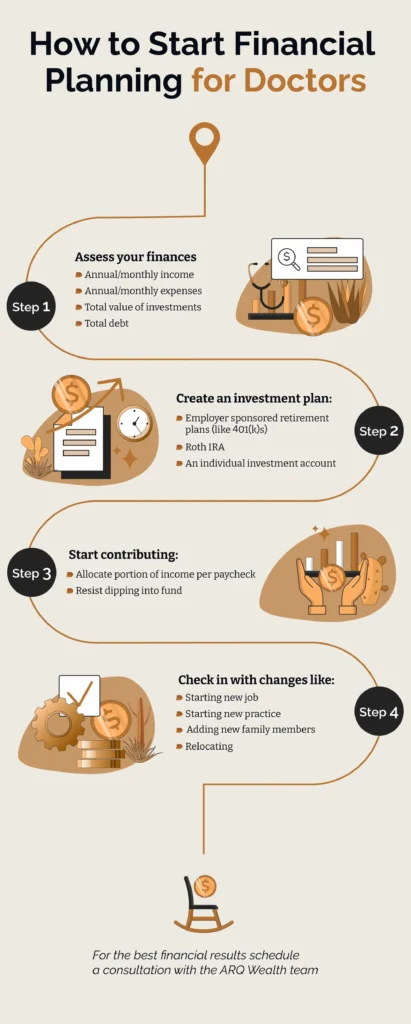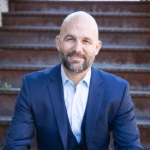Retirement planning for doctors can be a bit more extensive than it is for the rest of the general population. This is mainly because physicians have a dramatically different life journey and subsequent roadblocks than their peers. With this in mind, this article will take an in-depth look at retirement planning for doctors.
Advantages of Physician Retirement Planning
Being a physician has its perks when it comes to retirement planning.
Physicians are High-Earners
Examining the average salary of a doctor is a bit unhelpful since their salary depends so much on their niche.
Data from the White Coat Investor estimates that salaries can range anywhere from $221,126 for a pediatric infectious disease doctor to $788,213 for a neurosurgeon. At the same time, the Bureau of Labor Statistics estimates that the median annual wage for wage and salaried workers was just $56,950. Regardless of their specialty, doctors will earn more than most Americans.
How does this factor into a doctor’s retirement plan? Mainly, increased earnings will make it easier to save for retirement than their peers. Also, retirement accounts have limits. Doctors may need to get creative with their retirement plan:
- Individual Retirement Account Limits: The 2023 annual contribution limit for IRAs (Roth or Traditional) is $6,500, or $7,500 if you’re age 50 or older (2019, 2020, 2021, and 2022 is $6,000, or $7,000 if you’re age 50 or older).
- 401(k) Limits: The contribution limit for employees who participate in 401(k), 403(b), and most 457 plans, as well as the federal government’s Thrift Savings Plan, is $23,000 in 2024.
For the average American, contributing $6,500 to a Roth IRA might be a good goal. However, you may also need to explore other investment vehicles for growth, such as real estate, stocks, bonds, venture capital, or other assets.
This is why it is essential to speak with a financial advisor.
Disadvantages of Physician Retirement Planning
Choosing a medical profession also has some financial disadvantages.
Personal Finance isn’t Taught in Medical School
Completing medical school is one of the most challenging things a person can do. Upon graduation, students will have extensive knowledge about anatomy, physiology, biochemistry, pathology, pharmacology, and microbiology. They will also unfortunately be stricken with medical school debt.
Spending so much time in medical school means that you’ll likely find yourself far behind your peers when it comes to retirement savings. This is why selecting the right retirement plans is vital for physicians at any age.
Most Get a Late Start Saving
Most physicians get a late start on mapping out their retirement plans.
Someone who gets a job right out of high school could enroll in their company’s 401(k) account and start retirement planning at 18. However, someone who pursues the medical route will be almost thirty before they begin to enter the workforce. This means that most medical professionals usually miss out on roughly a decade (or more) of saving, investing, and generating compound interest.
Large Student Debt Load
The average medical school student graduates with $250,995 in total student loan debt, according to the Education Data Initiative. College debt amounts can vary widely depending on your specialty and financial aid package, and medical students have significantly more student loan debt than their peers. This can make it more difficult to start saving and contributing money to your retirement account – especially early in your career.
Potential Professional Roadblocks: Patient Relationships and Lack of Pensions
Most professions have the green light to retire once they have saved up enough money. However, physicians are responsible for considering their patients in their retirement plans. Physicians may also want to continue working later in life to continue helping people.
Additionally, when the time finally comes to retire, you’ll need to provide adequate notice to your patients or arrange for them to transition to a new physician. If you own your own practice, you’ll also need to create a succession plan for someone else to take over. All of this can add extra stress to the retirement planning process.
Finally, since many doctors are self-employed, they may not have access to an employer who will handle their retirement plans for them. Instead, the burden is on them to handle their retirement – on top of running their own practice.
How to Start Financial Planning For Doctors
If you haven’t started retirement planning yet then it might be best to simply schedule a consultation with a member of the ARQ Wealth team. We will provide extensive advice, regardless of whether you’re just starting in your career or are nearing retirement age.
Scheduling a consultation is advisable since retirement planning is such a personalized experience. However, there is also a simple 3-step process that you can use to get started planning for retirement:
- Assess your personal finances: This includes reviewing your annual income, total debt, and expenditures.
- Create an investment plan and timeline: Research how much money you need to retire. From there, you can reverse engineer the amount you need to retire.
- Commit to your plan and check in routinely: As a doctor, you already understand the importance of check-ups. Well, the same mentality applies to your personal finances. You should check your plan at least once a year, if not once a quarter.

Step 1: Assess Your Personal Finances
The first step when retirement planning for doctors is to assess your personal finances: income, expenses, investments, and debt. When assessing your finances, there are a few different things to look for:
- What is your annual/monthly income?
- What are your annual/monthly expenses?
- What is the total value of your investments
- How much debt do you have?
The ultimate goal is to bring in more money than you spend each month. However, if you’re not making more than you spend then you’ll need to make adjustments to your lifestyle in order to contribute to your retirement funds.
You should also compare your total investments to your total debt. This will give you a sense of how much more debt you have to pay off and how far along your retirement journey. This brings us to a common question that many physicians face.
Should I Repay Debt or Start Investing?
Is it better to repay your student loans first before you start investing? Or should you pay off your loans while you rush to invest your spare cash?
This is a common question in the medical world. Here’s a good starting point that can help you approach this problem:
- Find out your interest rate: Do some research to find out how much your interest rates are for your loans. You’ll likely have to track down a few different interest rates since you likely took out a few other loans. As a rule of thumb, an interest rate over 5-6% on your student loans is considered fairly high, while anything less than 5-6% is low.
- Learn your expected rate of return from investing: As a rule of thumb, the average rate of return in the stock market is 10% annually. If you plan to invest in the stock market, use 10% as a benchmark. But, if you plan to use fixed-income assets then your expected return will be lower.
- Compare the two: You want to determine if the interest rate on your loans is higher than the return you expect to receive from your investment. If your student loan has a higher interest rate than your expected return, prioritze paying down your debt first.
With that said, there is no law stating that you have to pay off all your debt first before you start investing. Considering your elevated income, there is likely room for paying down your debt each month while also contributing to your retirement accounts.
Step 2: Create an Investment Plan and Timeline
From here, you’ll need to determine the age at which you want to retire and how much money you’ll need. For example, some physicians may plan to continue working even after they reach the “standard” retirement age of 65. Others may want to retire early at 40 or 50. The age at which you want to retire determines how much you’ll have to save.
Once you have these numbers, you can calculate how much you need to invest each month in order to have enough to retire at your desired age. You’ll most likely have to commit to investing a certain amount each month. Over time, this contribution will snowball into a hefty nest egg.
There isn’t a “one size fits all” number when it comes to retiring. After all, the amount of money you’ll need during your golden years depends on your lifestyle. If you like to live a life of luxury then you’ll need a bigger nest egg. But, if you aren’t a big spender then you can get away with a much smaller retirement amount.
To learn more about how much you’ll need to retire, we’d recommend researching more using a retirement calculator. Additionally, you can also schedule a consultation with a financial advisor on the ARQ Wealth team who will be able to provide more personalized advice
Where Should I Start Investing?
There are a few standard investment vehicles that many physicians use to fund their retirement savings. The following retirement plans are the easiest places to get started:
- Employer-sponsored retirement plans: These plans are offered directly by your employer and include plans like 401(k)s. The advantage of investing in one of these plans is that you’ll enjoy tax benefits on your investment gains.
- Roth IRA: A Roth IRA is very similar to a 401(k) except that it’s not sponsored by your employer. Instead, you’ll need to set up your Roth IRA yourself. You can do this easily enough through most major financial providers. But, you can also enlist the help of a financial advisor to offer more guidance.
- An individual investment account: you can also set up an individual brokerage account. This will give you more flexibility on where you invest your cash. But, it won’t have the same tax benefits associated with the other retirement plans listed above.
Step 3) Commit to Your Plan and Check in Routinely
Once you’ve established an investment plan, it’s important to commit to your investments. The “planning” is the easiest part of the process. Contributing money to your retirement accounts each month is much more challenging. Consider creating automated withdrawals so that your money is deposited consistently from your checking account into your retirement account.
From there, you’ll also want to conduct regular checkups to ensure you’re still on pace to meet your goals. This is especially important since your circumstances are constantly changing. Each new year could bring changes like:
- Starting a new role or accepting a job with a new employer
- Deciding to start your own practice
- Moving to a new city, which brings new tax regulations and cost-of-living considerations
- Welcoming a child into your life
- Moving into a new home
By routinely checking in on your retirement plan, you can make any necessary changes as your circumstances change.
Retirement Planning for Doctors: Tips and Strategies
There are a few more tips and strategies to consider when mapping your retirement plan:
- Plan for higher taxes throughout your career: Your earnings will likely increase throughout your career as you become more experienced or grow your own practice. This means that you’ll need to prepare for a higher tax burden as the years go on.
- Make the most of employer contributions: Many employers offer employer contributions—meaning they will match any payments you make to your retirement account (up to a certain amount). Be sure to check to see if your employer offers these, as you may be leaving money on the table.
- Consider selling your practice: If you run your own practice, then you might want to consider selling it when you’re ready to retire. This will let you realize a hefty cash transfusion at the end of your career that can help pad your nest egg.
- Consider leasing real estate: If you own your own practice, you can save a significant amount of money by leasing your real estate instead of buying it. This tip varies by market. But with interest rates at record highs, leasing instead of owning real estate can help free up cash flow for you to invest.
- Consider making a “catch-up contribution”: The IRS allows people who are over the age of 50 to make additional contributions to their retirement plans. If this is you, then be sure to take advantage of this benefit, as it could help you pad your retirement savings accounts.
- Make the most of tax deductions: Tax deductions allow you to reduce your taxable income by subtracting certain expenses from your paycheck. However, you may want to speak with a financial planner before doing this, as they can help you with more advanced tax planning strategies.
Interested in getting a more customized retirement plan? If so, please schedule a consultation with one of the financial planners on the ARQ Wealth team today.

